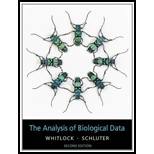
Concept explainers
a.
To state: The assumptions of the binomial distribution and check if the given case satisfies the required assumptions.
a.
Answer to Problem 1PP
Yes, it does satisfy the assumptions of the binomial distribution.
Explanation of Solution
Given:
Formula used:The binomial
The addition principle in binomial distribution X is shown as:
The assumptions of the binomial distribution are:
- There are only two outcomes for each trial, which are treated as a success and a failure.
- There are a fixed number of trials and each trial is independent of the other.
- The probability of success is the same for each trial.
In this case, the pathogenic isolates which are resistant are considered a success, and which are not resistant are considered a failure. There are a fixed number of trails or a fixed number of pathogenic isolates that are independent of each other.
The given example satisfies all the assumptions; so, the given example can be represented by binomial distribution.
b.
To find: The probability of success for the given example. Also, compute the value of n .
b.
Answer to Problem 1PP
The probability of success
The total number of trails
Explanation of Solution
From the above part, it is known that the percentage of pathogenic isolates that are resistant to antibiotic vancomycin
The probability of success or probability that a randomly selected pathogenic isolate is resistant to the antibiotic vancomycin
The total number of pathogenic isolates extracted from patients
c.
To calculate: The probability that exactly five pathogenic isolates are resistant.
c.
Answer to Problem 1PP
The probability is 0.025.
Explanation of Solution
Calculation:
The probability that exactly 5 pathogenic isolates show resistance to antibiotic vancomycin is calculated as shown below:
The required probability is 0.025.
d.
To calculate: The probability that exactly six pathogenic isolates are resistant and the probability that there are exactly seven resistant pathogenic isolates.
d.
Answer to Problem 1PP
The probabilities are 0.0036 and 0.0002 respectively.
Explanation of Solution
Calculation:
The probability that exactly 6 pathogenic isolates show resistance to antibiotic vancomycin is calculated as shown below:
Now,
Hence, the required probabilities are 0.0036 and 0.0002 respectively.
e.
To calculate: The probability of five or more pathogenic isolates are resistant using the principle of addition.
e.
Answer to Problem 1PP
The probability is 0.0288.
Explanation of Solution
Calculation:The probability that five or more pathogenic isolates are resistant is calculated as shown below:
It is known that,
Now,
The probability that there are five or more pathogenic isolates that are resistant is 0.0288.
Want to see more full solutions like this?
Chapter 7 Solutions
The Analysis of Biological Data
